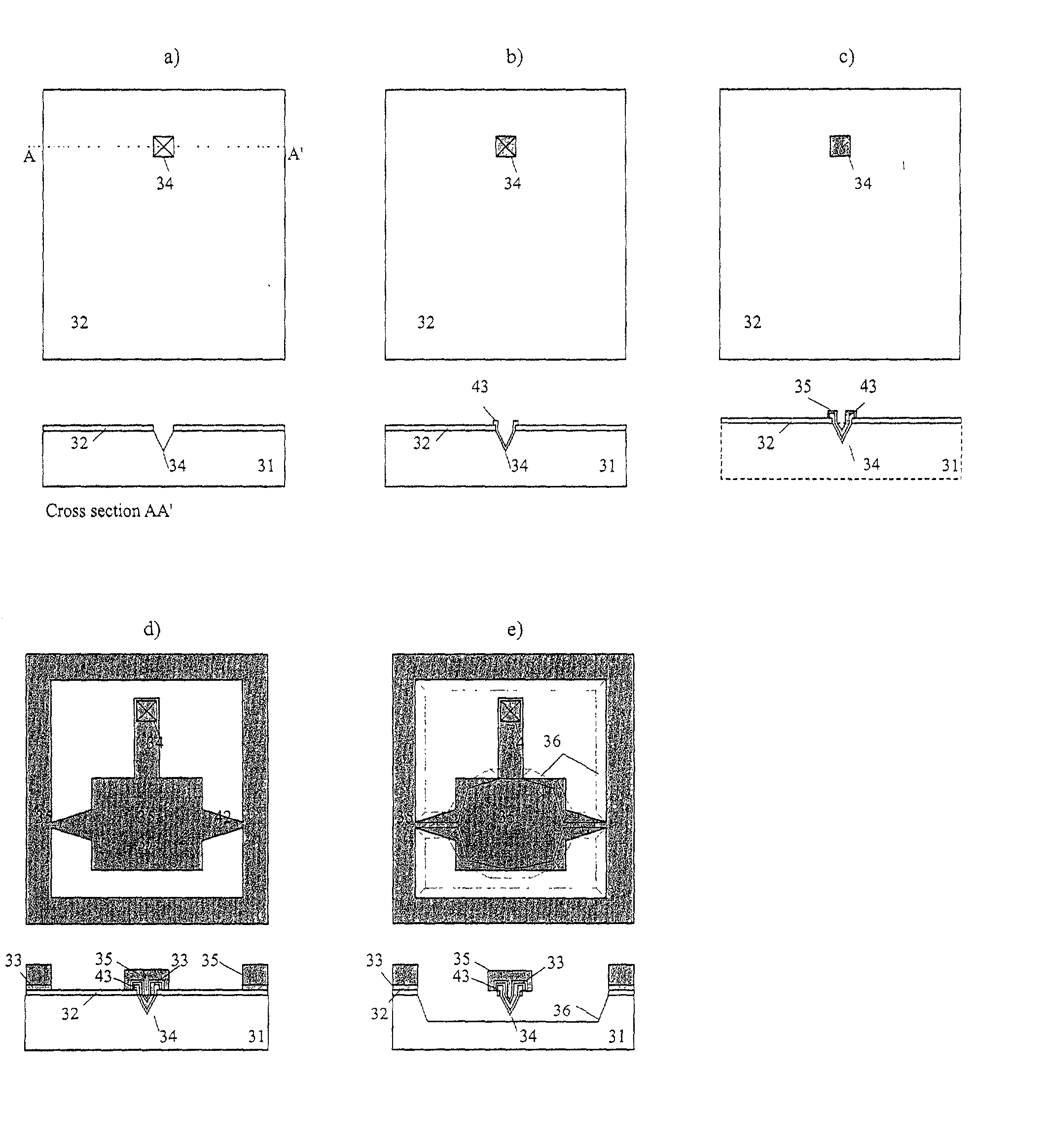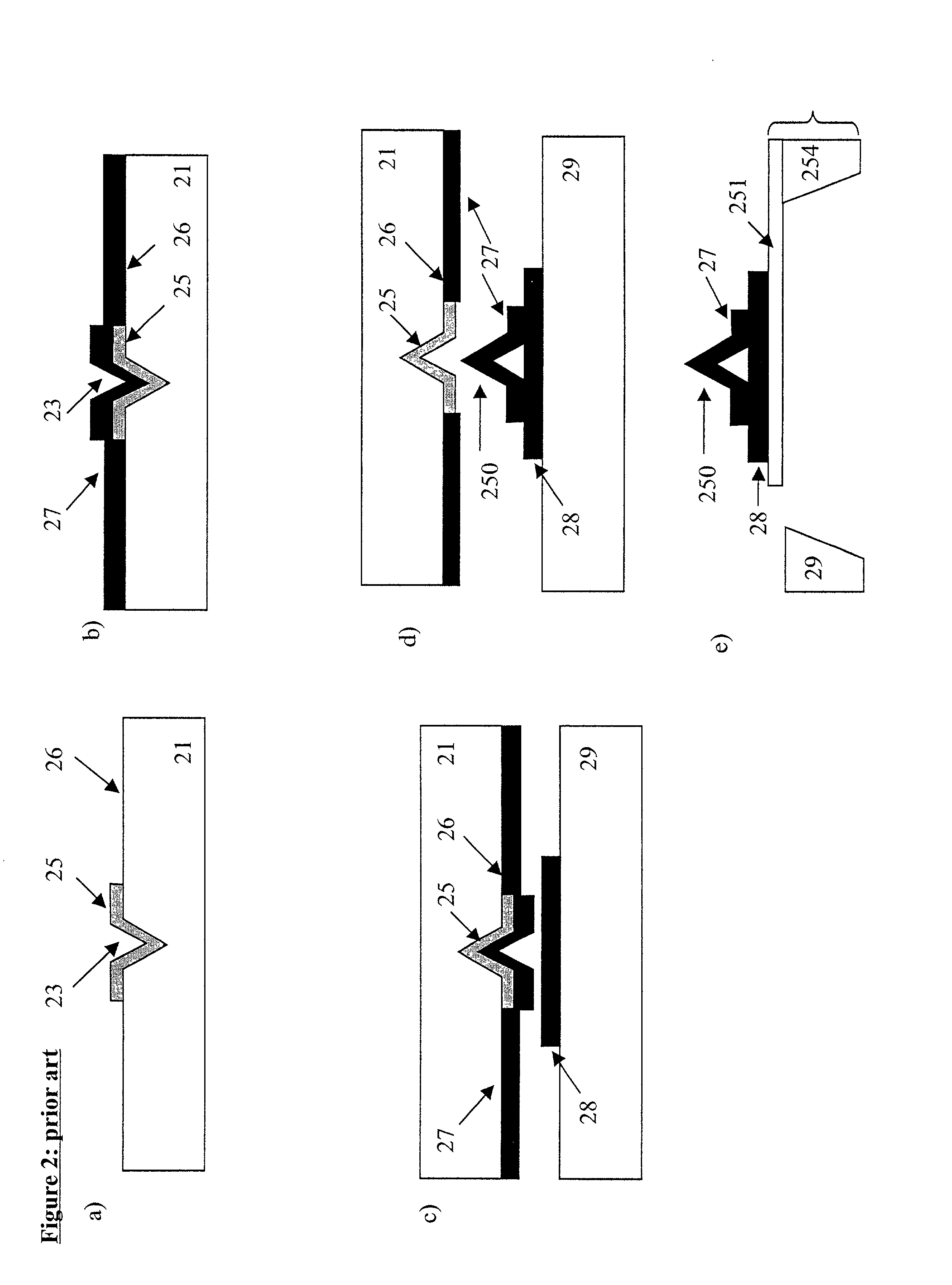Probe tip and method of manufacturing tips and probes for detecting microcurrent or microforce
a technology of microcurrent or microforce, which is applied in scanning probe microscopy, decorative arts, nanotechnology, etc., can solve the problems of substrate not being re-used, metal coating rapidly wears off, time-consuming steps, etc., and achieves cost-effective and time-saving effects, avoiding backside lithography and time-consuming etching steps
- Summary
- Abstract
- Description
- Claims
- Application Information
AI Technical Summary
Benefits of technology
Problems solved by technology
Method used
Image
Examples
first embodiment
[0042] In a first embodiment, a method of manufacturing a scanning probe requiring only front side processing steps is disclosed. This method comprises two front side lithographic steps. The peel-off effect is achieved by selectively metallising the area of the probe tip configuration. This metal layer has a sufficiently high enough adhesion to the substrate to allow further processing, but this adhesion force is weak enough to be overcome when peeling the probe gradually from the wafer.
[0043] This method comprises the following steps. During the first patterning step a mould (34a) is formed in the starting substrate (31), preferably a silicon wafer. (FIG. 3a) This mould may have one of various shapes, e.g., pyramidal, a truncated cone, a cylinder. In case a silicon wafer is used a truncated pyramidal etch pit is formed by anisotropically etching the substrate trough an opening defined in a masking layer formed on top of the substrate. Such a masking layer can be a photo resist or a...
second embodiment
[0048] In a second embodiment, the method of manufacturing a full metal probe with two front side lithographic steps is disclosed.
[0049] The starting substrates (31) were (100)-Si wafers having a diameter of 150 mm. These wafers were covered with 470 nanometer (nm) thermally grown oxide (32), SiO.sub.2, and 150 nm low-pressure chemical vapour deposited (LPCVD) nitride, Si.sub.3N.sub.4. (see FIG. 3a) Photoresist was spun onto the wafers and squares (34) of 40.times.40 square micrometer (.mu.m.sup.2) were opened in the photoresist during the first lithography step. These squares define the tip area (34). This resist pattern was then transferred to the Si.sub.3N.sub.4 layer by reactive ion etching (RIE) using a SF.sub.6:O.sub.2 etching mixture. Next, the resist was removed and the nitride pattern was transferred to the SiO.sub.2 layer by etching the oxide layer with buffered HF (BHF). Inverted pyramids were then etched in 30% KOH at 70.degree. C. for 55 minutes. The wafer surface was c...
PUM
| Property | Measurement | Unit |
|---|---|---|
| thick | aaaaa | aaaaa |
| diameter | aaaaa | aaaaa |
| thick | aaaaa | aaaaa |
Abstract
Description
Claims
Application Information
 Login to View More
Login to View More - R&D
- Intellectual Property
- Life Sciences
- Materials
- Tech Scout
- Unparalleled Data Quality
- Higher Quality Content
- 60% Fewer Hallucinations
Browse by: Latest US Patents, China's latest patents, Technical Efficacy Thesaurus, Application Domain, Technology Topic, Popular Technical Reports.
© 2025 PatSnap. All rights reserved.Legal|Privacy policy|Modern Slavery Act Transparency Statement|Sitemap|About US| Contact US: help@patsnap.com



